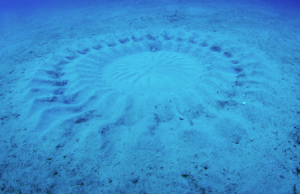
Art is hard enough to define when it is created by humans, but what about when wild animals make objects that look like art?
Consider Torquigener albomaculosus, more commonly known as the white-spotted pufferfish. Found in the coastal waters of subtropical Japan, this amazing fish has the distinction of being the most accomplished underwater animal artist discovered to date.
The males of this species are known for creating large circular-shaped patterns in the sand. Although the fish are only five inches long, their sand sculptures can be as much as seven feet in diameter. They begin their sculptures by digging a circular valley in the sand using their fins. Then, by swimming at various angles from the outside of the circle to the inside, they create radially aligned peaks and valleys in the sand. In the center of the circle they swim back and forth to form a textured plateau. When the form is complete, they focus on surface ornamentation by adding shell fragments and fine sediment. Their creations can take as long as nine days to complete.

The aesthetically-pleasing sand sculptures created by these tiny fish call to mind environmental art installations and the mandalic-like forms of Tibetan sand paintings.
Until 2012, no one knew who or what created these beautiful undersea “crop circles.” But then scientists figured out it was the white-spotted pufferfish males.
So what drives these fish to create such spectacular structures? They do it for love. Or at least for the possibility of attracting mates. After the males complete the construction of their circles, females come by to check out them out. If a female finds a circle pleasing, she will mate with the male, which essentially means she will lay eggs at the center of the sand circle and then the male fertilizes them externally. The work of art then becomes a nest.
No one knows what the female is looking for when she shops for a nest. Some scientists believe that the females might be interested in the fine sediment the males use to decorate the surface of the sculpture. They think that the radial design helps to hold the sediment in place. But that is just speculation at this point.
Charles Darwin once opined that some birds have “fine powers of discrimination” and could even be shown to “have a taste for the beautiful.” I am sure he would have said the same about Torquigener albomaculosus had he seen their fascinating sand nests. For more info, check out the paper by scientists Hiroshi Kawase, Yoji Okata and Kimiaki Ito and watch the video below to see a Torquigener albomaculosus at work. You’ll even get to see him add a shell to the edge of his circle!